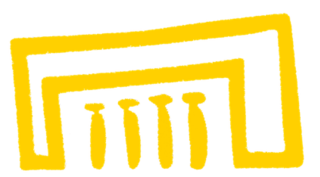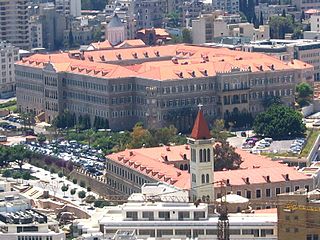
Beirut is the capital and largest city of Lebanon. As of 2014, Greater Beirut has a population of 2.5 million, which makes it the third-largest city in the Levant region. The city is situated on a peninsula at the midpoint of Lebanon's Mediterranean coast. Beirut has been inhabited for more than 5,000 years, and was one of Phoenicia's most prominent city states, making it one of the oldest cities in the world. The first historical mention of Beirut is found in the Amarna letters from the New Kingdom of Egypt, which date to the 14th century BC.

Byblos, also known as Jbeil or Jubayl, is a city in the Keserwan-Jbeil Governorate of Lebanon. It is believed to have been first occupied between 8800 and 7000 BC and continuously inhabited since 5000 BC, making it one of the oldest continuously inhabited cities in the world. During its history, Byblos was part of numerous civilizations, including Egyptian, Phoenician, Assyrian, Persian, Hellenistic, Roman, Fatimid, Genoese, Mamluk and Ottoman. The city is a UNESCO World Heritage Site.

Sarepta was a Phoenician city on the Mediterranean coast between Sidon and Tyre, also known biblically as Zarephath. It became a bishopric, which faded, and remains a double Catholic titular see.

Tell Tweini, possibly the ancient town of Gibala, is a 12 hectare archaeological site located 1 kilometre east of the modern city of Jableh, Syria. It is situated within the coastal plain of Jableh, a short distance of two other main archaeological sites: Tell Sukas (5 km) and Tell Siyannu (6 km). As a tell, the site is the result of centuries of habitation on the same place, which resulted in a rising mound, as every new generation built their houses on top of the remains of older structures. The tell is sited about 1.7 kilometers from the coast but it appears that in the Bronze Age a sea incursion provided a harbor access to the sea.

Sumur was a Phoenician city in what is now Syria. It was a major trade center. The city has also been referred to in English publications as Simyra, Ṣimirra, Ṣumra, Sumura, Ṣimura, Zemar, and Zimyra.

The National Museum of Beirut is the principal museum of archaeology in Lebanon. The collection begun after World War I, and the museum was officially opened in 1942. The museum has collections totaling about 100,000 objects, most of which are antiquities and medieval finds from excavations undertaken by the Directorate General of Antiquities. About 1300 artifacts are exhibited, ranging in date from prehistoric times to the medieval Mamluk period.
Tell el-Burak is located in a lush agricultural section of southern littoral of Lebanon, it has been under investigation by the American University of Beirut and the University of Tübingen since 1998. The excavations have revealed three occupations on the tell, the latest in the Ottoman Period, the next in the Iron Age, and the earliest in the Middle Bronze Age.
Peter M. Fischer is an Austrian-Swedish archaeologist. He is a specialist on Eastern Mediterranean and Near Eastern archaeology, and archaeometry. He belongs to the University of Gothenburg and is associated with the Austrian Academy of Sciences, Sweden. He is the founder and director of the Swedish Jordan Expedition, the Palestinian-Swedish Expedition at Tall al-Ajjul, Gaza. He became the director of the Swedish Cyprus Expedition in 2009 and carried out excavations at Hala Sultan Tekke since 2010. He is member/corresponding member of The Royal Society of Arts and Sciences in Gothenburg, Royal Swedish Academy of Letters, History and Antiquities. and The Austrian Academy of Sciences.

The Museum of Lebanese Prehistory is a museum of prehistory and archaeology in Beirut, Lebanon.
The Sands of Beirut were a series of archaeological sites located on the coastline south of Beirut in Lebanon.
Leila Badre is a Lebanese archaeologist and director of the Archaeological Museum of the American University of Beirut.
Tell Kazel is an oval-shaped tell that measures 350 m × 325 m at its base, narrowing to 200 m × 200 m at its top. It is located in the Safita district of the Tartus Governorate in Syria in the north of the Akkar plain on the north of the al-Abrash river approximately 18 km (11 mi) south of Tartus.

The Phoenician port of Beirut, also known as the Phoenician Harbour of Beirut and archaeological site BEY039 is located between Rue Allenby and Rue Foch in Beirut, Lebanon. Studies have shown that the Bronze Age waterfront lay around 300 metres (330 yd) behind the modern port due to coastal regularisation and siltation. It was excavated and reported on by Josette Elayi and Hala Sayegh in 2000 and determined to date to the Iron Age III and Persian periods. Two nineteenth-century Ottoman docks were also unearthed during construction, just to the north of this area at archaeological sites BEY018 and BEY019.
Ralph K. Pedersen is a nautical archaeologist from Levittown New York, United States. He was the DAAD Gastdozent für Nautische Archäologie at Philipps-Universität Marburg 2010–2013, and has been distinguished visiting professor in anthropology and Knapp Chair in Liberal Arts at the University of San Diego, and the Whittlesey Chair Visiting Assistant Professor in the department of history and archaeology at the American University of Beirut. He has been teaching online courses in archaeology in the History Department at Southwestern Assemblies of God University since 2009.

Cypriot Bichrome ware is a type of Late Bronze Age, and Iron Age, pottery that is found widely on Cyprus and in the Eastern Mediterranean. This type of pottery is found in many sites on Cyprus, in the Levant, and also in Egypt. It was typically produced on a pottery wheel. A large variety of decorations and motifs are attested. This pottery is very similar to certain types of the Mycenaean pottery from various locations.
The Ancient Tell is a Tell in downtown Beirut, Lebanon. In the 1990s, the effort to rebuild Beirut following the Lebanese Civil War provided archaeologists with the unique opportunity to investigate the Tell, revealing many layers of the city.

The Phoenico-Persian Gate of ancient Tell is a monument located in downtown Beirut, Lebanon.
The Canaanite Tombs of ancient Tell are a historical monument located in downtown Beirut, Lebanon.

The Byblos figurines or Phoenician statuettes are approximately 1,500–2,000 ex-voto statuettes found in ancient Phoenician temples in Lebanon, primarily in Byblos, but also in Kamid al lawz. The statuettes date to the second millennium BC and are made of bronze, silver, or copper alloy. The Byblos figurines are considered to represent the best example of their kind across the Levant.














